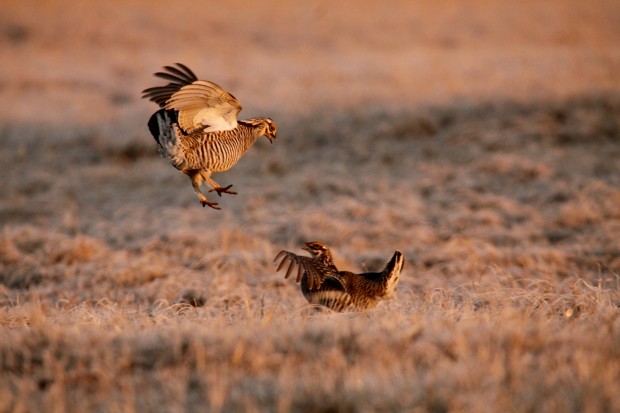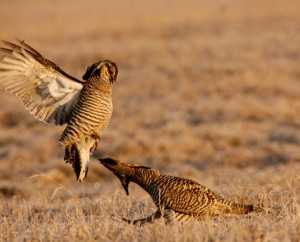We have much more to do and your continued support is needed now more than ever.
Be My Wingman – Dance of the Greater Prairie Chicken
“The sound is just a long drawn out ‘boom’; you can just tell it’s a very old song that’s been going on for thousands of years. Kind of like an alarm clock in spring telling you to wake up; it’s something you have to experience, I can’t describe it.” – Aaron Price
Nebraska rancher Aaron Price is referring to the “boom” of the male prairie chicken calling for a mate in spring. The distinctive sound is accompanied by a dance that we can enjoy courtesy of You-tube in this video of a South Dakota grassland prairie chicken.
[youtube]http://www.youtube.com/watch?v=pJCy0d94YS0[/youtube]
But videos can’t compete with a real life experience. If you want to see the prairie chicken dance in person, you can go to the First Annual 2012 Nebraska Prairie Chicken Festival hosted by Calamus Outfitters and the Gracie Creek Landowners.
The event is organized by landowners of three ranches that border each other in Nebraska. Due to the good stewardship of the ranch owners over the years, greater prairie chickens have been thriving. Sarah Sortum of Calamus Outfitters, who is organizing the event, says that the landowners “wanted to do something, because we were really just excited about what we’ve been doing, the birds, and what we have to offer. We weren’t sure how to get the word out, so we came up with the festival idea. Landowners are excited to show the project area and educate the public that by and large private landowners are responsible stewards—sometimes we get a bad rap. And we also just want to have fun.”

“It’s kind of like a fraternity, a bunch of guys trying to pair up and push the weaker ones out of the territory and attract females. The males group up normally in twos and try to work their way to the middle.”
After the early morning dance, the festival begins with a Native American traditional prairie chicken dance. Each day there are activities: ranch tours, kids activities, and talks from several speakers – including keynote speaker Michael Forsberg, a celebrated conservation photographer.
The Nebraska festival is one of several events celebrating the prairie chicken; there are also festivals in Wisconsin, Oklahoma, and New Mexico, attended by many people who celebrate wildlife. Sortum and the other landowners have been doing a lot worth celebrating. Says Sortum:
“We have a comprehensive stewardship plan, with an umbrella of biodiversity goals we’re working toward: controlling invasives, restoring native hydrology, implementing grazing management. You come to find out there’s a reason people live here—they love to see the wildlife and the grasslands. It’s a form of community planning, even though we’re a rural community. What do we want our resource to look like in the next 20 years?”

- Take a trip! Visit the Calamus Outfitters website to read more about how to attend the 2012 Nebraska Prairie Chicken Festival, and go see the dance. And don’t miss Ryan Stockwell of NWF, who will be speaking the 21st on the importance of the Farm Bill in protecting grasslands.
- Write to your Congressman or Senator and ask them to help the Lesser Prairie Chicken and other grassland species by adding a Sodsaver provision to the next Farm Bill, which will protect native grasslands from being converted to cropland while keeping land available for grazing.





















